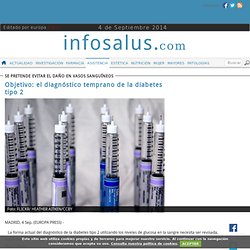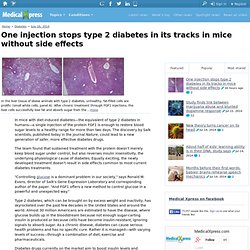

Witter / ? Scientists at IRB Barcelona dance for cancer, Alzheimer’s and diabetes research. Sur Twitter : "Cure for Type 1 #diabetes imminent after Harvard stem-cell breakthrough, by @sarahknapton. Cure for Type 1 diabetes imminent after Harvard stem-cell breakthrough. Witter / ? Objetivo: el diagnóstico temprano de la diabetes tipo 2. MADRID, 4 Sep.

(EUROPA PRESS) - La forma actual del diagnóstico de la diabetes tipo 2 utilizando los niveles de glucosa en la sangre necesita ser revisada, según sugiere una investigación realizada por científicos de la Universidad de Manchester y del 'King's College London', en Reino Unido. Los resultados, publicados este miércoles en 'Plos One', muestran que el método actual de diagnóstico con los niveles de glucosa en la sangre significa que se detecta demasiado tarde en los pacientes de forma que sus vasos sanguíneos ya se pueden estar dañados. La diabetes tipo 2, que afecta a más del 90 por ciento de todos los adultos con diabetes, a menudo conduce a daños al corazón y los vasos sanguíneos, así como problemas en el cerebro, los ojos y los riñones. Así, esta condición está estrechamente vinculada a los crecientes niveles de obesidad, falta de ejercicio, dietas poco saludables y envejecimiento de nuestra población.
Insulina inhalable: Una revolución para millones de diabéticos en breve. Sanofi-Aventis acaba de recibir la licencia mundial para producir Afrezza, un inhalador que pretende sustituir a las tradicionales inyecciones para el tratamiento de diabetes tipo 1 y 2.

Se espera que sea lanzado al mercado en Estados Unidos en menos de 6 meses (primer trimestre de 2015). Aunque no es el primer tratamiento inhalable, sí puede ser una revolución por su reducido tamaño, la tara que tuvieron los anteriores proyectos. Inhalador de Afrezza producido por MannKind Corporation – Fotografía de Pharmalife. Scientists show type-1 and type-2 diabetes are caused by same underlying mechanism. Work by scientists at the Universities of Manchester and Auckland suggest that both major forms of diabetes are the result of the same mechanism.

The findings, published today in the FASEB Journal (20 August), provide compelling evidence that juvenile-onset or type-1 diabetes and type-2 diabetes are both caused by the formation of toxic clumps of a hormone called amylin. The results, based on 20 years' work in New Zealand, suggest that type-1 and type-2 diabetes could both be slowed down and potentially reversed by medicines that stop amylin forming these toxic clumps. Professor Garth Cooper, from The University of Manchester working with his University of Auckland-based research team, led the study. As well as producing insulin, cells in the pancreas also produce another hormone called amylin. Insulin and amylin normally work together to regulate the body's response to food intake. Explore further: New look identifies crucial clumping of diabetes-causing proteins. Low-cost production of proinsulin in toba... [Plant Biotechnol J. 2011] Some saturated fatty acids may present a bigger risk to diabetes than others.
The relationship between saturated fat and type 2 diabetes may be more complex than previously thought, according to the results of a large international study published today in the journal Lancet Diabetes and Endocrinology.

The study found that saturated fatty acids can be associated with both an increased and decreased risk of developing the disease, depending on the type of fatty acids present in the blood. The results add to the growing debate around the health consequences of fat, and could partially explain evidence from recent studies that suggests some foods high in saturated fats, such as dairy products, could actually lower the risk of type 2 diabetes. Saturated fat is typically found in foods with a high proportion of animal fat, such as butter, cheese and red meat, and in fried foods. It is made up of chains of individual fat molecules (fatty acids) that vary in length, depending on how many carbon atoms they contain. One injection stops type 2 diabetes in its tracks in mice without side effects. In mice with diet-induced diabetes—the equivalent of type 2 diabetes in humans—a single injection of the protein FGF1 is enough to restore blood sugar levels to a healthy range for more than two days.

The discovery by Salk scientists, published today in the journal Nature, could lead to a new generation of safer, more effective diabetes drugs. The team found that sustained treatment with the protein doesn't merely keep blood sugar under control, but also reverses insulin insensitivity, the underlying physiological cause of diabetes. Equally exciting, the newly developed treatment doesn't result in side effects common to most current diabetes treatments. "Controlling glucose is a dominant problem in our society," says Ronald M. Evans, director of Salk's Gene Expression Laboratory and corresponding author of the paper. Type 2 diabetes, which can be brought on by excess weight and inactivity, has skyrocketed over the past few decades in the United States and around the world.